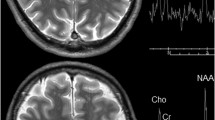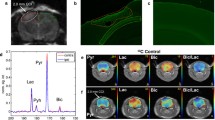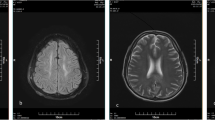Abstract
Introduction
Brain temperature (BT) is associated with the balance between cerebral blood flow and metabolism according to the “heat-removal” theory. The present study investigated whether BT is abnormally altered in acute and subacute CO-poisoned patients by using 1H-magnetic resonance spectroscopy (MRS).
Methods
Eight adult CO-poisoned patients underwent 3-T magnetic resonance imaging in the acute and subacute phases after CO exposure. MRS was performed on deep cerebral white matter in the centrum semiovale, and MRS-based BT was estimated by the chemical shift difference between water and the N-acetyl aspartate signal. We defined the mean BT + 1.96 standard deviations of the BT in 15 healthy controls as the cutoff value for abnormal BT increases (p < 0.05) in CO-poisoned patients.
Results
BT of CO-poisoned patients in both the acute and subacute phases was significantly higher than that of the healthy control group. However, BT in the subacute phase was significantly lower than in the acute phase. On the other hand, no significant difference in body temperature was observed between acute and subacute CO-poisoned patients. BT weakly correlated with body temperature, but this correlation was not statistically significant (rho = 0.304, p = 0.2909).
Conclusions
The present results suggest that BT in CO-poisoned patients is abnormally high in the acute phase and remains abnormal in the subacute phase. BT alteration in these patients may be associated with brain perfusion and metabolism rather than other factors such as systemic inflammation and body temperature.




Similar content being viewed by others
References
Weaver LK (2009) Clinical practice. Carbon monoxide poisoning. N Engl J Med 360:1217–1225
Thom SR, Bhopale VM, Fisher D, Zhang J, Gimotty P (2004) Delayed neuropathology after carbon monoxide poisoning is immune-mediated. Proc Natl Acad Sci U S A 101:13660–13665
Beppu T, Nishimoto H, Fujiwara S et al (2011) 1H-magnetic resonance spectroscopy indicates damage to cerebral white matter in the subacute phase after CO poisoning. J Neurol Neurosurg Psychiatry 82:869–875
Beppu T, Nishimoto H, Ishigaki D et al (2010) Assessment of damage to cerebral white matter fiber in the subacute phase after carbon monoxide poisoning using fractional anisotropy in diffusion tensor imaging. Neuroradiology 52:735–743
De Reuck J, Decoo D, Lemahieu I et al (1993) A positron emission tomography study of patients with acute carbon monoxide poisoning treated by hyperbaric oxygen. J Neurol 240:430–434
Nybo L, Secher NH, Nielsen B (2002) Inadequate heat release from the human brain during prolonged exercise with hyperthermia. J Physiol 545:697–704
Yablonskiy DA, Ackerman JJ, Raichle ME (2000) Coupling between changes in human brain temperature and oxidative metabolism during prolonged visual stimulation. Proc Natl Acad Sci U S A 97:7603–7608
Whiteley WN, Thomas R, Lowe G et al (2012) Do acute phase markers explain body temperature and brain temperature after ischemic stroke? Neurology 79:152–158
Yamada K, Sakai K, Akazawa K et al (2010) Moyamoya patients exhibit higher brain temperatures than normal controls. Neuroreport 21:851–855
Ishigaki D, Ogasawara K, Yoshioka Y et al (2009) Brain temperature measured using proton MR spectroscopy detects cerebral hemodynamic impairment in patients with unilateral chronic major cerebral artery steno-occlusive disease: comparison with positron emission tomography. Stroke J Cereb Circul 40:3012–3016
Karaszewski B, Wardlaw JM, Marshall I et al (2006) Measurement of brain temperature with magnetic resonance spectroscopy in acute ischemic stroke. Annals Neurol 60:438–446
Cady EB, D’Souza PC, Penrice J, Lorek A (1995) The estimation of local brain temperature by in vivo 1H magnetic resonance spectroscopy. Magn Reson Med 33:862–867
Beppu T (2014) The role of MR imaging in assessment of brain damage from carbon monoxide poisoning: a review of the literature. AJNR Am J Neuroradiol 35:625–631
Chen NC, Huang CW, Lui CC et al (2013) Diffusion-weighted imaging improves prediction in cognitive outcome and clinical phases in patients with carbon monoxide intoxication. Neuroradiol 55:107–115
Folstein MF, Folstein SE, McHugh PR (1975) “Mini-mental state”. A practical method for grading the cognitive state of patients for the clinician. J Psychiatr Res 12:189–198
Yoshioka Y, Oikawa H, Ehara S et al (2005) Noninvasive measurement of temperature and fractional dissociation of imidazole in human lower leg muscles using 1H-nuclear magnetic resonance spectroscopy. J Appl Physiol 98:282–287
Murakami T, Ogasawara K, Yoshioka Y et al (2010) Brain temperature measured by using proton MR spectroscopy predicts cerebral hyperperfusion after carotid endarterectomy. Radiology 256:924–931
Kao CH, Hung DZ, ChangLai SP, Liao KK, Chieng PU (1998) HMPAO brain SPECT in acute carbon monoxide poisoning. J Nuclear Med 39:769–772
Choi IS, Kim SK, Lee SS, Choi YC (1995) Evaluation of outcome of delayed neurologic sequelae after carbon monoxide poisoning by technetium-99m hexamethylpropylene amine oxime brain single photon emission computed tomography. Eur Neurol 35:137–142
Powers WJ, Raichle ME (1985) Positron emission tomography and its application to the study of cerebrovascular disease in man. Stroke J Cereb Circul 16:361–376
Watanabe N, Nohara S, Matsuda H et al (2002) Statistical parametric mapping in brain single photon computed emission tomography after carbon monoxide intoxication. Nucl Med Commun 23:355–366
Weaver LK, Howe S, Hopkins R, Chan KJ (2000) Carboxyhemoglobin half-life in carbon monoxide-poisoned patients treated with 100% oxygen at atmospheric pressure. Chest 117:801–808
Cronje FJ, Carraway MS, Freiberger JJ, Suliman HB, Piantadosi CA (2004) Carbon monoxide actuates O(2)-limited heme degradation in the rat brain. Free Radic Biol Med 37:1802–1812
Kuroda S, Shiga T, Houkin K et al (2006) Cerebral oxygen metabolism and neuronal integrity in patients with impaired vasoreactivity attributable to occlusive carotid artery disease. Stroke J Cereb Circul 37:393–398
Fujiwara S, Beppu T, Nishimoto H et al (2012) Detecting damaged regions of cerebral white matter in the subacute phase after carbon monoxide poisoning using voxel-based analysis with diffusion tensor imaging. Neuroradiology 54:681–689
Beppu T, Fujiwara S, Nishimoto H et al (2012) Fractional anisotropy in the centrum semiovale as a quantitative indicator of cerebral white matter damage in the subacute phase in patients with carbon monoxide poisoning: correlation with the concentration of myelin basic protein in cerebrospinal fluid. J Neurol 259:1698–1705
Saini M, Saqqur M, Kamruzzaman A, Lees KR, Shuaib A, Investigators V (2009) Effect of hyperthermia on prognosis after acute ischemic stroke. Stroke J Cereb Circul 40:3051–3059
Shiraki K, Sagawa S, Tajima F, Yokota A, Hashimoto M, Brengelmann GL (1988) Independence of brain and tympanic temperatures in an unanesthetized human. J Appl Physiol 65:482–486
Acknowledgments
We appreciate the supports of members of the Department of Psychiatry and Department of Neurology of Iwate Medical University, and members of Iwate Prefectural Advanced Critical Care and Emergency (Morioka, Iwate, Japan). We also appreciate the support of Dr. Makoto Sasaki (M.D., Ph.D.) and Yutaka Matsumura (R.T.) of Iwate Medical University. This work was partly supported in part by the following grants: Grant-in-Aid for Scientific Research (C) (No. 22592020, 2012–2014 and No. 15K09935, 2015–2018) and Grant-in-Aid for Strategic Medical Science Research (S1491001, 2014–2018) from the Ministry of Education, Culture, Sports, Science and Technology of Japan.
Author information
Authors and Affiliations
Corresponding author
Ethics declarations
Compliance with ethical standards
We declare that all human and animal studies have been approved by the Ethics Committee at Iwate Medical University (Morioka, Japan) and have therefore been performed in accordance with the ethical standards laid down in the 1964 Declaration of Helsinki and its later amendments. We declare that all patients gave informed consent prior to inclusion in this study.
Conflict of interest
We declare that we have no conflict of interest.
Electronic supplementary material
Below is the link to the electronic supplementary material.
ESM 1
(DOC 30 kb)
Rights and permissions
About this article
Cite this article
Fujiwara, S., Yoshioka, Y., Matsuda, T. et al. Brain temperature measured by 1H-magnetic resonance spectroscopy in acute and subacute carbon monoxide poisoning. Neuroradiology 58, 27–32 (2016). https://doi.org/10.1007/s00234-015-1600-y
Received:
Accepted:
Published:
Issue Date:
DOI: https://doi.org/10.1007/s00234-015-1600-y




